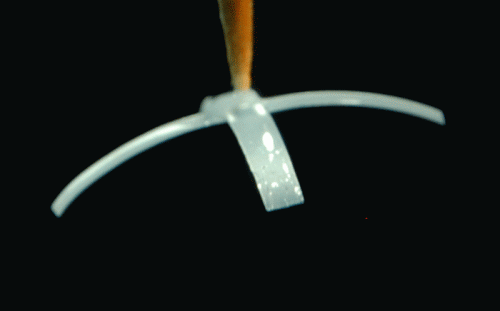The Magic of Scotch Tape | Seek n' Geek X

Figure 1: Classic Scotch Magic Tape
Scotch Magic Tape (TM) is magic for a reason - and the formula is well guarded. Magic tape is one of the most ubiquitous in the line of 3M's pressure sensitive tapes. Richard Drew is credited with this line of transparent cellotape, which purportedly took off as a product during the Great Depression when people wanted to fix items instead of buying new ones. [1] [2] Since the 1930's a number of additional special qualities and properties have been discovered in Scotch tape that augments its use in everything from creating x-rays to acting as a substrate for flexible electronics, or even as a medium for embossing braille dots.
Total thickness is 0.060 mm comprised of a cellulose acetate backing and a synthetic acrylic adhesive. The unwinding force and adhesion data can be used to calculate total friction in a system where the tape winds around various rollers, similar to the manufacturing process shown in

Table 1: Excerpt from 3M Technical Datasheet of Scotch Tape properties


Figure 2: Diagram of a tape manufacturing process and on the left a demonstration of the difference between matte Magic Tape (B) and satin finish (A) on tape transparency
Cellulose acetate is made from cotton or wood fibers and treated with acetic acid (found in vinegar) which swaps hydrogens with acetyl groups, allowing the polymer to dissolve and be extruded into sheets. [3] Other material components of the tape include acrylics as part of the secret adhesive recipe, polydimethyl-siloxane a release coating to prevent the tape from sticking to itself, and a styrene acrylic or polyurethane that joins the adhesive to the film. These components are described in this Wired article.
The release coating composition, importance, and means of measuring are discussed in the introduction to 3M patent US6352766B1.



Figure 3: Graph of the surface roughness of Scotch Magic Tape as measured in a Nature article titled "Ubiquitous Graphene Electronics on Scotch Tape" [4]
Table 2: Features, advantages and benefits of Scotch Magic Tape from Technical Datasheet
Another extraordinary use of magic tape is documented by a grad student from Purdue University who observed Scotch tape's ability to capture small samples of water by curving four beams inwards when exposed to water. The curvature occurs because the cellulose acetate on top expands when exposed to moisture while the adhesive repels water. [5] Experimental photos are shown below, where on the left the tape is coated with small magnetic particles to allow an electro magnet to pick up the gripper.
Finally, Scotch tape is also documented to create x-rays when unrolled in a vacuum in which the particles are able to accelerate until they collide with a solid object and emit x-rays. Scientists are still working to figure out the physics behind this phenomenon. [6]


References
[1] Wikipedia Scotch Tape
[2] Wikipedia Richard Drew
[3] Wired What's inside the secret recipe for Scotch Magic Tape
[4] Nature Ubiquitous Graphene Electronics on Scotch Tape
[5] Phys.org Scotch Tape Smart Grasping Material
[6] Symmetry The physics of Scotch Tape